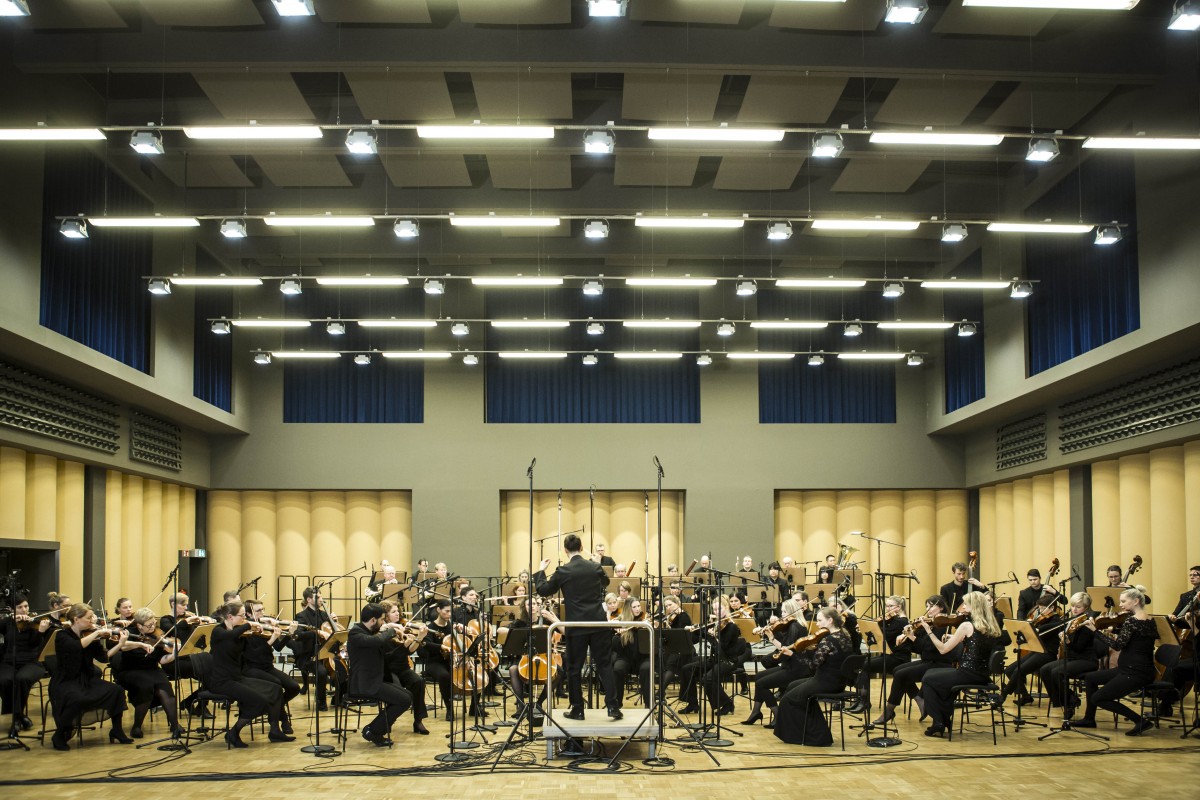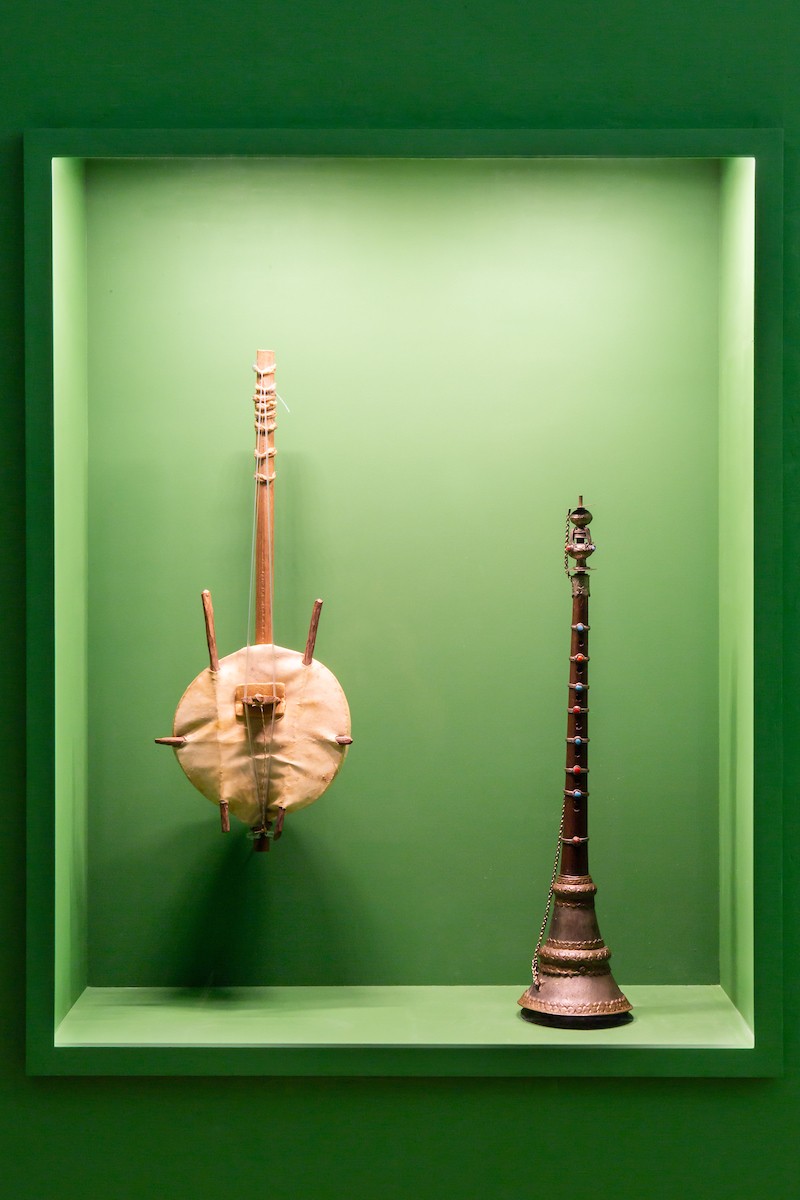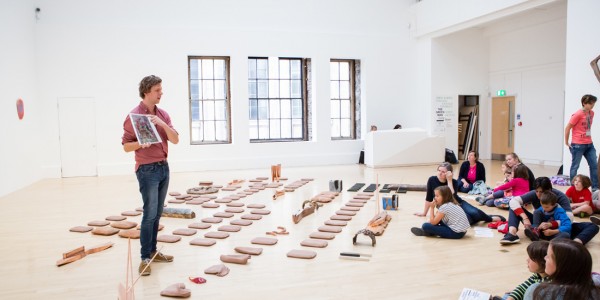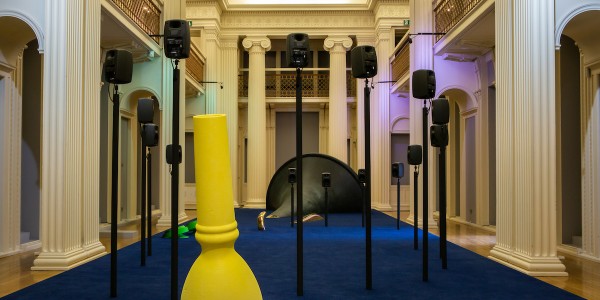Samson Young / Real Music
-

Samson Young
Talbot Rice Gallery and the University of Edinburgh are proud to present the first solo exhibition in the UK by acclaimed Hong Kong artist and composer, Samson Young (b. 1979). At the heart of the exhibition is an ambitious collaboration with the University of Edinburgh’s Next Generation Sound Synthesis (NESS) research group, who have developed pioneering software that can generate the sound of virtual instruments. For historians this offers the opportunity to hear lost objects, while for Samson Young it is an opportunity to hear the impossible.
A new series of installations entitled Possible Music, 2018–ongoing, are borne from this encounter, the artist composing music for instruments that do not exist in reality. 'Possible Music #2', commissioned for the exhibition at Talbot Rice Gallery and Monash University Museum of Art, pushes the parameters of this technology by orchestrating the effects of scale, temperature and force. How would a bugle sound, for instance, if it was activated by the fiery breath of a dragon, superheated to 300 degrees Celsius? Within Young’s 16-channel sound garden, a field of speakers sprout towards the cupolas overhead, while mixed media sculptural forms allude to a colossal, oversized trumpet emerging from the carpeted earth. This impossible rendition is complimented by a new body of work on paper, colourful, textured graphic scores.
Talbot Rice Gallery will also premier a new video performance- lecture by Young entitled 'The world falls apart into facts', generated from the artist’s extensive research into the Chinese folk song 'Molihua' (Jasmine Flower). Tracing its different versions and their claims to authenticity, this work is a genealogical telling of the song’s story, with the artist adopting an ironic ethnographic gaze. Accompanying this are a number of items that derive from Young’s exploration of the University of Edinburgh’s collections, including Pieter Neefs the Elder's 'Interior of a Cathedral' from the University’s Torrie Collection and a class of musical instruments often described as ‘tourist instruments’ held at St Cecilia’s Hall.
The exhibition will include 'Muted Situation #22: Muted Tchaikovsky’s 5th', 2018 (commissioned by Sydney Biennale in 2017) – a 12-channel sound installation - in which an orchestra performs the work on muted instruments. Tchaikovsky’s 5th is replaced with the startling and powerful sound of the orchestra itself – pulsing, heaving and expressive as a physical, concentrated body.
The exhibition has been curated by Tessa Giblin, Director of Talbot Rice Gallery, and Charlotte Day, Director of Monash University Museum of Art, Melbourne. Real Music will tour to MUMA 2 May – 4 July 2020.
'Real Music' will be accompanied by a fully illustrated catalogue available at Talbot Rice Gallery, Monash University Museum of Art and through Koenig Books. Designed by Stuart Geddes and Žiga Testen, with contributions by Stefan Bilbao, Alexandra Chang, Charlotte Day, Tessa Giblin, Alexander Rehding, Joel Stern and Samson Young.
Multi-disciplinary artist Samson Young was trained as a composer, and graduated with a Ph.D. in Music Composition from Princeton University in 2013. Young has had solo exhibitions at the Kunsthalle Düsseldorf, Centre for Contemporary Chinese Art in Manchester, M+ Pavilion in Hong Kong, and Hiroshima City Museum of Contemporary Art, among others. In 2017, he represented Hong Kong in a solo project at the Hong Kong Pavilion of the 57th Venice Biennale. Group exhibitions include Solomon R. Guggenheim Museum, New York; Shanghai Biennale; Biennale of Sydney; National Museum of Art, Osaka; National Museum of Modern and Contemporary Art, Seoul; and documenta 14: documenta radio; amongst others. Furthermore, he has participated in multiple festivals, as well as been the recipient of several prizes, including the 2019 Prix Ars Electronica, 2018 Hong Kong Art Centre Honorary Fellowship and 2015 BMW Art Journey Award. Further awards include Artist of the Year (Hong Kong Arts Development Council), Bloomberg Emerging Artist Award.
Share
Exhibition Guide
Published on the occasion of 'Samson Young - Real Music' at Talbot Rice Gallery, The University of Edinburgh. With contributions from Tessa Giblin, Director of Talbot Rice Gallery and Charlotte Day, Director of Monash University Museum of Art, Melbourne.
Texts are available to view below or download. A large print guide is also available to download.
Curators' Intro | Tessa Giblin, Director of Talbot Rice Gallery & Charlotte Day, Director of Monash University Museum of Art, Melbourne
Talbot Rice Gallery and the University of Edinburgh are proud to present the first solo exhibition in the UK by acclaimed Hong Kong artist and composer, Samson Young (b. 1979). Young’s installations, performances, videos and works on paper – all vibrating with colour and sound – are studies of the impossible, the hypothetical and the all too real. Straddling experimental worlds of art and music and informed by intensive research processes, his artworks move us to look, listen and imagine, while drawing attention to how often our perception is blinkered.
At the heart of the exhibition is an ambitious collaboration with the University of Edinburgh’s Next Generation Sound Synthesis (NESS) research group, who have developed pioneering software that can generate the sound of virtual instruments. For historians this offers the opportunity to hear lost objects, while for Samson Young it became an opportunity to hear the impossible. A demonstration of the catalyst that is the University of Edinburgh, where the meeting of contemporary art, research and resources can suddenly open up opportunities for innovation, it led to the newly commissioned 'Possible Music #2'. Young’s critical questioning of authenticity in music and in culture runs throughout the exhibition with 'Muted Situation #22: Muted Tchaikovsky’s 5th', a muted rendition of the canonical piece; 'The world falls apart into facts', a new film about the misconstrued translation of the Chinese 'Molihua (Jasmine Flower)' song; 'Orchestrations', Young’s playful visual scores; and pieces from the University of Edinburgh’s historic collections.
'Real Music' is a title and a provocation to unfix notions of authenticity at play in music, sculpture and society. Music and the visual arts are both disciplines plagued, bounded and sometimes policed by ideas of authenticity, attracting both purists and iconoclasts. Conflicts around authorship, legitimacy and accuracy are instrumentalised – and at times weaponised – on the stages of history, the sciences, popular culture, leisure, tourism, consumer goods, politics and interpersonal relations. Authenticity is also entangled with power, with proclamations of authenticity revealing deep relations to authority.
This exhibition has been jointly developed by Talbot Rice Gallery, University of Edinburgh, and Monash University Museum of Art, Melbourne, and is accompanied by a catalogue published by Koenig Books, London, available at Talbot Rice Gallery during the exhibition. That the 'Real Music' exhibition and accompanying publication have been produced by two galleries embedded in educational settings demonstrates the vital, research-driven contribution that universities can make to contemporary art production today.

Possible Music #2
Samson Young, 'Possible Music #2', 2019
3D-printed nylon, soft pastel, Jesmonite, polyurethane foam, timber, plywood, plaster, paint, bronze, 16-channel sound installation, 10 short compositions at regular intervals
In developing this exhibition, Young collaborated closely with the Next Generation Sound Synthesis (NESS) research group within the University of Edinburgh, utilising the NESS-created system that simulates the sound of vanished or hypothetical musical instruments in a specific environment. A new series of sound installations entitled Possible Music, 2018– ongoing, was borne of this encounter. The artist then composed music for instruments that could never exist. How would a bugle sound, for instance, if it was activated by the fiery breath of a dragon, and superheated to 300 degrees Celsius? 'Possible Music #2', commissioned for the Georgian Gallery, bends the rules of both music and sculpture. Within Young’s sound garden, a field of speakers sprout towards the cupolas overhead, while 3D-printed, bronze and Jesmonite sculptural forms allude to a colossal, oversized brass instrument emerging from the carpeted earth.
Young complicates the production of the objects by using both digital and analogue processes – sometimes employing one to produce the other. While his sculptural forms are created entirely from digital hypotheses, they are manifested alternatively in 3D-print, craft techniques and foundry casting. Whether through ancient or data-driven techniques, the experience of 'Possible Music' is at once experimentally futuristic and archaeologically suggestive.
Commissioned and co-produced by Talbot Rice Gallery, University of Edinburgh, and Monash University Museum of Art, Melbourne, with support from the Keir Foundation. Courtesy of the artist and Galerie Gisela Capitain, Cologne

Orchestrations
Samson Young, 'Orchestrations', 2019
Ink, pastel, colour pencil and watercolour on paper with artist frame (3D-printed PLA), each 30 × 21 cm
Drawing has long played a role for Young in depicting the world of sound – describing what is heard rather than seen. His colourful and textured graphic scores and ongoing series of sound drawings notate bells, birdsong and explosions on paper, or visually represent sounds in different landscapes.
In Young’s words, "orchestration is the art of combining instrumental timbre to achieve specific sounds, colours, textures or effects. Within these drawings I am thinking of orchestration as a metaphor for the assemblage of people, and the combination of sounds and voices that these assemblies generate – specifically in situations of mass protests. These are mixed in with hypothetical orchestrations (e.g., the sound of a contrabass pitched above a piccolo)." The series questions what is possible in reality and what barriers delimit our imagination.
All works courtesy the artist unless states otherwise.

Muted Situations #22: Muted Tchaikovsky’s 5th
Samson Young, 'Muted Situations #22: Muted Tchaikovsky’s 5th', 2018. Single-channel HD colour video, 12-channel sound installation, carpet, 45 mins
Alongside Young’s new artworks the exhibition features 'Muted Situation #22: Muted Tchaikovsky’s 5th', 2018, originally commissioned by the 21st Biennale of Sydney. It is part of a major strand in Young’s practice – the series of ‘muted’ performances that the artist has been producing as video and sound installations since 2014, working in collaboration with different ensembles and orchestras. In 'Muted Situation #22: Muted Tchaikovsky’s 5th', we witness Thomas Jung conducting Cologne’s Flora Sinfonie Orchester in a muted performance of Tchaikovsky’s 'Symphony No. 5'. Young’s script for this performance explains, ‘In these “muted performances” a specific layer of sound, usually the most audible layer, is consciously suppressed. As a result, the other layers of sonic texture will re-emerge as the foreground. In the case of 'Muted Situation #22: Muted Tchaikovsky’s 5th', it is the pitched layer that is being consciously suppressed. This is achieved through a series of workshops and in close collaboration with the musicians.’ Gripped with the same intensity of a normal performance and responding to the bodies of the musicians with familiar passion and fervour, the muted instruments emit the odd squeak or errant toot, as the concentrated exertion of not bowing the strings or not blowing the horns is defeated by muscle memory.
The exploration of silence has a long history in experimental music. Famously, experiencing an anechoic chamber at Harvard University (a space designed to cut out every sound), John Cage heard the sound of his own heartbeat and central nervous system and concluded that there was no such thing as silence.
Cage’s work 4’33’’ involved a concert pianist sitting down, opening a piano lid and then simply waiting that length of time, focusing the audience’s attention upon all the other noises of the concert hall and its surroundings. For Cage this was a way of allowing sounds to ‘be themselves’. Conversely, Samson Young makes work that opposes the idea that sounds can ever transcend a specific cultural and political situation, shifting the emphasis from silence in itself to the constructed mutedness of a situation.
In his words, ‘If Cagean silence is sort of idealistic in its reliance on and its trust of the frame, then mutedness is pragmatic in its trust of the experiment and the process to produce surprising results. Who knew an orchestra of muted strings vis-a-vis the orchestration of Tchaikovsky (Muted Situation #22: Muted Tchaikovsky’s 5th (2018)) would sound like the sea? With the Muted Situations series, you just don’t know until you start workshopping the pieces with the performers. The score isn’t this perfect thing where the work is. The work is in the process and the result of the process, which include also all the different ways that it exceeds and falls short of the vision as outlined in the blueprint.’


The world falls apart into facts
Samson Young, 'The world falls apart into facts', 2019
Two-channel HD video, colour, sound (Horse Togaku for harpsichord, voices, automated-percussions, electronics, a tourist wind instrument and a horse), 25 mins
Also created by Samson Young for 'Real Music' is a video performance-lecture titled 'The world falls apart into facts', which derives from the artist’s extensive research into Molihua (Jasmine Flower), as well as a fantastical counterfactual account of a Togaku (music from the Tang dynasty) piece, replete with a harpsichordist and ensemble in fruit costumes.
A well-known Chinese folk song, Molihua (Jasmine Flower) was transcribed for Western audiences in the late eighteenth century, although it is believed to have originated much earlier. Adopting artist Paul Carter’s understanding of echoic mimicry, Young uses the genealogy of Molihua as a case study about cross-cultural encounters. The version of the song we now understand to be synonymous with Chinese culture actually most closely resembles the version transcribed by English statesman John Barrow while on the first British embassy to China. Barrow’s tune and accompanying travelogue exploded in popularity across Europe, eventually making it back to its ‘native’ land, before being reabsorbed into Chinese identity. With other cases of such encounters, including Kenny G’s influence on Hong Kong pop music and centuries-unchanged Japanese Togaku now used as one of few extant sources of Tang dynasty court music, Young considers what it means to hear with the ears of an Other and questions notions of cultural purity and authenticity at large.
One of the first versions of Molihua that was disseminated to Western audiences was an arrangement published by Karl Kambra circa 1796. John Barrow’s first-hand account published as the tome 'Travels in China' in 1804, which also includes this score, is on display in the exhibition. Folded into Young’s two-channel video is also his exploration of a class of musical instruments often described as ‘tourist instruments’, examples of which form part of a historical collection held at the University of Edinburgh’s St Cecilia’s Hall. Items from the collection – the rgya-gling (monastic oboe) and a miniature bridge-harp or harp-lute – also feature in the exhibition. Typically created for a foreign market, these instruments perform their cultural dissonance, being markedly different from the originals they are modelled on.
Two paintings complete Young’s exploration of Molihua: Pieter Neefs the Elder’s 'Interior of a Cathedral' from the University’s Torrie Collection; and a damaged Cantonese ‘export painting’. The Cantonese ‘export painting’ is for Young another example of the effect of realising one’s own culture in a foreign tongue – this time, in painting. In Samson’s words, these paintings from the mid-eighteenth to mid-nineteenth century, were ‘aimed predominantly for the Western market using “Western” techniques. But, of course, due to lack of training, these imitations do not really look like the Western ideal that these Chinese artists attempted to copy. Rather than viewing these imperfections as flaws, I find myself really drawn to them – like an accent, an effigy of a pre-linguistic self, a version of these artists before the trauma of becoming a model minority or a reasonable merchant.’
Pieter Neefs the Elder’s 'Interior of a Cathedral', a treasure from the University’s Torrie Collection, was made after many of the churches in Western Europe were damaged during the iconoclastic events of the Reformation. Like many Dutch and Flemish painters, Pieter Neefs the Elder adapted perspective techniques to paint both real and fictional spaces. At the time of this painting – as Catholicism was re-established – efforts were being made to restore these buildings, demonstrated here by the suspended altar pieces that were known to be in disrepair at the time of painting.
In the context of 'Real Music', the historical contradictions of this period and the assemblage of artistic devices might suggest a complex reality in which the possibility of authentic and coherent spaces are brought into question.

University collections
Sir John Barrow (1764–1848), 'Travels in China: containing descriptions, observations, and comparisons, made and collected in the course of a short residence at the imperial palace of Yuen-Min-Yuen, and on a subsequent journey through the country from Pekin to Canton...', second edition, London, 1806. Illustrations by Hickey, W. Alexander, and S. Daniell; engraved by T. Medland and Neele
University of Edinburgh, Special Collections: SD 6593
Pieter Neefs the Elder (1578–1661), 'Interior of a Cathedral' , no date
oil on panel, 29 × 39 cm
Torrie Collection, University of Edinburgh. Accession no. EU0726
Rgya-gling (Monastic oboe), Nepal, pre-1971
Tourist instrument, wood and metal rings with semi-precious stones, chain, bell of metal alloy, 58 cm
MIMEd 3673, Gift of Geoffrey Samuel, 1996
Musical Instrument Collection, University of Edinburgh
Kora (Bridge-harp), The Gambia, c.1970
Tourist instrument, resonator made of gourd, sound-table of buckskin tacked with iron nails, 4 strings, 59 cm
MIMEd 1514, Gift of W.H. Stevenson
Musical Instrument Collection, University of Edinburgh
Samson Young collection
Canton school export painting, c.1900, oil on paper mounted on framed panel 94 × 173 × 2 cm
Thanks
Samson Young would like to thank production assistants Vvzela Qu and Lily Yiyi Chan, and studio technician Andrew Crowe (MetaObjects).
Talbot Rice Gallery (TRG) would like to thank Edinburgh College of Art, including the Reid School of Music and the School of Art; in particular, Stefan Bilbao, Stuart Bennett, Elaine Kelly, Christian Weikop, Linda O’Keefe, Joan Smith, Judith Miller and Francine Shields.
Thanks also to our colleagues in the wider University of Edinburgh: Peter Mathieson, Dorothy Miell, Chris Cox; and colleagues in the Centre for Research Collections: Jonathan Santa Maria Bouquet, Sarah Deters, Jenny Nex, Elizabeth Quarmby Lawrence, Jill Forrest as well as Joseph Marshall, Jacky MacBeath and Jeremy Upton.
We express our warm gratitude to the John Florent Stone Fellowship, which allowed Samson Young to engage with Edinburgh College of Art in such depth.
Special thanks go to Phillip Keir and Sarah Benjamin, Vvzela Qu, Regina Fiorito, Gisela Capitain, Edouard and Lorraine Malingue, Ivy Lin, Jessie So, Pui Pui Chan, Biennale of Sydney, and Amanda Catto and Lottie Thorne at Creative Scotland.
Monash University Museum of Art (MUMA) acknowledges the support of our MUMA Contemporaries towards this exhibition: Professor Wendy Brown, Andrew Cook, David Clouston and Michael Schwarz, Professor Shane Murray, Dr Sarah Kemp and Kris te Lintelo, Stephen and Keryn Nossal, Sandra Beanham, Fiona Brockhoff, Lisa Byrne, Wendy Foard and Peter Bate, P.J. Jopling AM QC, Mike Kendall, Chris McLoughlin, Galvin O’Meara Family, Maudie Palmer AO, Bruce Parncutt AO, Sue Rose, Bernard Shafer, Helen Stewart and Irene Sutton.
Further thanks to TRG team, particularly Melissa MacRobert, Colm Clarke, James Clegg and Stuart Fallon.
Thanks also to our wonderful Volunteer Exhibition Assistants.
Installation supported by Tam Aitchison, Pavlos Georgiou, Adrien Howard, Casey Miller and Chris Walker. Plaster casting by Uist Corrigan; IT support Dave Taylor; audio support from Reid School of Music, Roderick Buchanon-Dunlop and Ana Esparza Betancourt; 3D printing and metalwork, Catriona Gilbert, Paul Diamond, Malcolm Cruickshank and Giulia Gentili. With special thanks to Jack Handscombe for his work on Possible Music #2, supported by Lorenzo Robertson and Hamish Young.
Thanks to Glenn and Ayesha at Amber Arts.
Production facilities: Samson Young Studio, Edinburgh College of Art, Powderhall Bronze, Talbot Rice Gallery, Reid School of Music.
MUMA Curators – Exhibitions: Francis Parker and Research: Melissa Ratliff.
Finally, we extend our most sincere thanks to Samson Young, whose practice freely moves between analogue and digital media, a broad range of formats and mediums, as well as disciplines and cultural and physical borders. Young is a deep thinker and avid producer of ideas whose imagination knows no bounds.
Film credits
The world falls apart into facts, 2019
Director, composer and scriptwriter: Samson Young
Horse Togaku musicians: Leon Chu (voice), Cherry Shi (voice),
Geneva Fung (harpsichord), Samson Young (native American style tourist instrument)
Production management: Jones Lee
Sound editing: Samson Young and Teeda Lee
Sound technician: Teeda Lee
Video editing: Samson Young and Vvzela Qu
Camera operators: Ip Yiu Tung Zachary, Lau Chun
Sing, Leung Tin Chun Jimmy, Lee Chun Wai and Leung Ho Sing Documentation photography: Lily Yiyi Chan
Voiceover: Dr Christian Weikop
Production assistants: Vvzela Qu, Teeda Lee and Christie Wong Courtesy of the artist
Muted Situations #22: Muted Tchaikovsky’s 5th, 2018
Musicians: Flora Sinfonie Orchester
Director: Thomas Jung
Sound and video editing: Samson Young and Vvzela Qu.w Commissioned by the Biennale of Sydney with generous support from the Art Promotion Office and the Hong Kong Visual Arts Centre of the Leisure and Cultural
Services Department
Courtesy of the artist; Edouard Malingue Gallery, Hong Kong; and Galerie Gisela Capitain, Cologne
Published by Talbot Rice Gallery on the occasion of Samson Young | Real Music 2019 at the University of Edinburgh
Texts written by Tessa Giblin and Charlotte Day Proofreading by Miranda Blennerhassett
Photography by Sally Jubb*. All exhibition views courtesy Talbot Rice Gallery.
Curated by Tessa Giblin and Charlotte Day
All rights reserved. The translation, the total or partial adaptation and the reproduction by any means (including microfilm, film and photocopies), as well as the electronic storage, are reserved in all countries.
The publishers would like to thank all those who have given their kind permission to reproduce material for this book. Every effort has been made to achieve permission for the images and texts in this catalogue. However, as in standard editorial policy for publications, the publisher remains available in case preliminary agreements were not able to be made with copyright holders.
©2019 the artists, writers and Talbot Rice Gallery ISBN 978-0-9955287-9-6
Talbot Rice Gallery, The University of Edinburgh, Old College, South Bridge, Edinburgh, EH8 9YL, UK






















